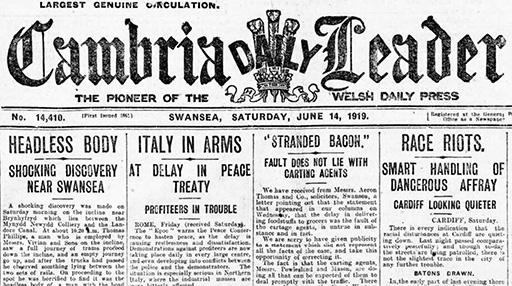5 Local backlash: Cardiff ‘race riots’

Sexual jealousy, a lack of understanding about Islam, and tensions over racist ‘Whites First’ employment practices in the economic depression following the First World War all contributed to the explosion of what were termed ‘race riots’ in Cardiff on 11 June 1919. Discriminatory housing policy, alongside a desire for community cohesion, meant that the Arab community was largely confined to Butetown. As a result, they were easily targeted. Over several nights, mobs attacked Arab lodging houses, businesses and homes. Several people were hospitalised, others were arrested, and three men died as a result of the rioting.
Newspaper coverage of the riots reveals contemporary racist attitudes.
Activity 1
Read the following article from the Manchester Guardian covering the riots in Cardiff and answer the following questions:
- Look at the language used to describe the people targeted by the rioters. What kinds of racial assumptions does the correspondent make in his descriptions?
- What sense do you get of the tension between coal miners, sailors and soldiers? Can you explain this?
BATON CHARGE BY THE POLICE
(From our correspondent)
Strong precautions were taken last night to prevent a recurrence of the colour trouble, for thousands of young miners came down to the city from the colliery villages, bend on fun. The police formed a strong cordon around the approach to the negro town, and no one was permitted to go to the docks district unless he or she resided there or was on business bent. Coloured men moved freely about in the encircled area and gave no trouble, though they congregated in large crowds to discuss the situation.
Just at dusk a solitary Malay sailor ventured into the city, and his appearance was the immediate cause of a riot. A soldier in khaki was the first to notice him, and rushed upon him, followed by an angry crowd. The police, mounted and on foot, rushed to the rescue and succeeded in scattering the mob and in arresting both the soldier and the Malay. They took them through some by-streets to the central police station, but as they emerged again into the main street the crowd, sympathising with the soldier under arrest, made an attempt at rescue. An ugly rush took place, and at one time it appeared as if the police would be over-powered. Just then reinforcements arrived under Superintendent Charles Jones, placed themselves between the crowd and the prisoner, and in self-defence the order to charge was given. The police, with truncheons drawn, lay about with vigour, and the disturbance was eventually quelled, but several of the crowd were taken to the infirmary.
There were further signs of unrest later in the evening, and at eleven o’clock the order came to clear the streets, and this the police did most effectually.
There was trouble also, at the colliery village of Taffs Well, some miles from Cardiff, where a coloured collier resided with his white wife. A threatening crowd congregated in front of his house and insisted that he should leave the village. It appeared at one time as if a riot would develop, but the police intervened, and eventually the negro and his wife took a taxi-cab and drove into Cardiff, where all the coloured races of the district are now gathered within a prescribed area.
Discussion
Contemporaries, including the media and the police, often were imprecise in their description of ethnicity. They often relied on racialised stereotyping, generic assumptions about national origins, and language that we would find unacceptable today (e.g. ‘coloured’) to describe people who were viewed as ethnically or racially different to the white Welsh population.
It is not a coincidence that tensions arose between lascar sailors, miners and soldiers. Soldiers returning to Wales after demobilisation often found themselves dislocated from life and work which had continued without them during the First World War. Competition in employment, and the tendency to underpay Arab workers, contributed to the perception that work, housing and other resources were being unfairly taken by ‘foreign’ men. This was not peculiar to Cardiff: in the summer of 1919, a series of riots broke out in the United Kingdom and the USA where race and racism were central causal factors.
Often the response of the authorities, namely the police and government, was to blame the ‘foreign’ community. In this case, you can see that the solution was to cordon off Butetown and ensure that the population was not able to mix with residents in other parts of Cardiff. This segregation often served to further separate the different ethnic populations of a city. Again, the Chief Constable of Cardiff was not alone in proposing this response to the riots; segregation was replicated in other cities that had experienced similar types of rioting.
